
‘12
The Raspberry Farmer
On Sunday, we attended the celebration of Akio Suyematsu's life. Akio was a Nisei Japanese farmer, a Bainbridge island original and friend of my great-uncle Alfred. He and his family were part of Bainbridge Island's history as the strawberry capitol of the United States before the second World War; after the war, he managed to buy back their farm by working multiple jobs to pay back the "interest on interest" that had accrued during his family's internment.
In his later years, Akio worked with the city of Bainbridge to conserve working farmland as a part of the island's future. The farm that he worked and shared with several other farmers is now the oldest continuously-farmed landscape in Kitsap County.
We heard many touching eulogies, but the one echoing in my mind is a poem by Issa.
The man pulling radishes
Points the way
With a radish
Perfect. Akio was remembered to us by his family and fellow farmers — starting in his raspberry rows before dawn and working until midnight, setting an example of hard work and generosity, quietly pointing the way for the island's next generation of farmers.
‘12
Berries of Bainbridge
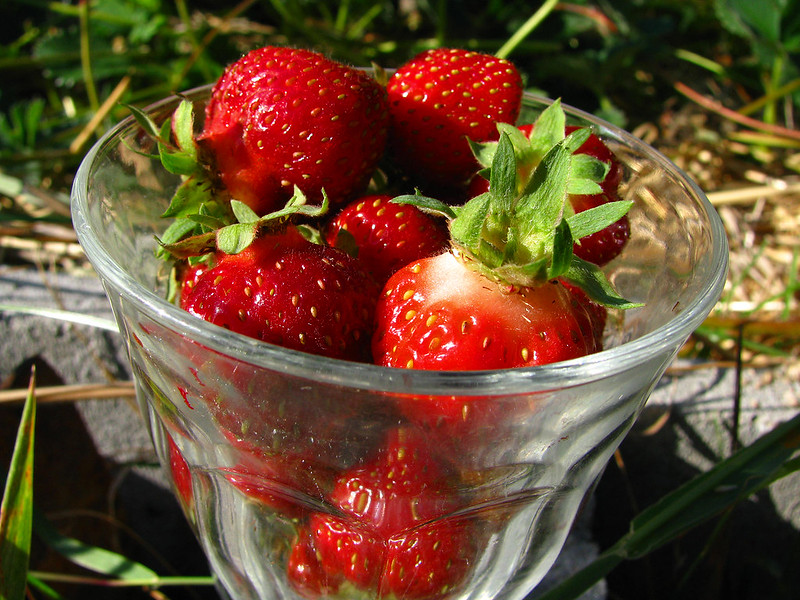
A glass full of strawberries.
This spring we built a raised bed and purchased strawberries from Raintree Nursery. Most of the bed was planted with the Tri-Star cultivar, which started bearing in late June and has been fruiting ebulliently ever since. The only thing that slowed down our strawberries was a nocturnal visit from some deer, who defoliated about half of the plants. Now we've covered the garden bed in chicken wire and there are more berries than ever.
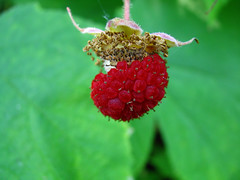
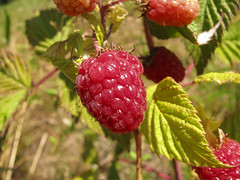
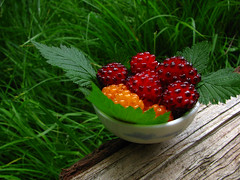
Thimbleberries, Raspberries, and Salmonberries
Sola and I have crowned the thimbleberry as our favorite of the native berries. It is both more flavorful and more friendly to encounter in the woods than salmonberries or blackberries. Although it grows in thickets like salmonberries, it has no thorns and is soft and fuzzy to the touch. We've found that foraging for thimbleberries is a quest with the best sort of ephemeral reward. Thimbleberries are extremely delicate and can be crushed just by carrying them down the trail in your palm — better to let them melt in your mouth as you pick! Erik's one-word review: "Scrumptious."
You may recall our raspberry experiment started earlier this year. I can't say it was a rousing success; most of the canes planted in the straw bales are stunted and unhealthy. Those planted in the ground have fared better, with the pair of Cascade Delight plants outperforming other varieties. The few raspberries we've harvested were, of course, delights.
Salmonberries are a beautiful local berry with a long history. One of the stories related to their name is that local salmon spawn around the time the bushes bloom. The berries ripen in early June, and are welcome as an early fruit that brightens the rainy weather. The trouble with salmonberries is their inconsistency: Erik describes most salmonberries as being insipid. Even so, I found myself eating them by the handful. The red berries, which are less common here than the golden variety, have a richer flavor and are less likely to be bitter or flavorless.
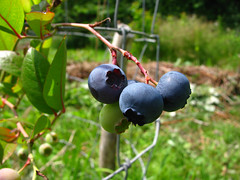

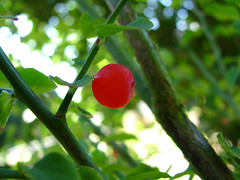
Blueberries and Huckleberries
We planted seventeen blueberry bushes around the time we put the strawberries in, and have more-or-less ignored them since then. Sure, we've weeded around them occasionally, but otherwise we've left them alone. In spite of our neglect, they've thrived, with every bush bearing a handful or two of berries. We planted eleven different varieties, which has meant they've all ripened at different times of summer. Still, we had to augment our own crop with blueberries from the Bainbridge Island Blueberry Co. Maybe next year we'll be a bit more blueberry self-sufficient.
We currently have scotch broom as a makeshift hedgerow along much of our property. It's terribly invasive stuff (and is poisonous to horses), which means we're actively looking for a replacement. We don't yet have any blue huckleberries on our property, but a few blocks up the road they provide a half-wild fence. Blue huckleberries are a handsome bush, with fruit that are sweeter and somewhat less seedy than red huckleberries, though trending towards tart. It might be fair to say they split the difference between blueberries and red huckleberries.
Red Huckleberries are tiny, seedy berries that grow wild in the local forests — including the wooded parts of the farm. As with thimbleberries, I have fond memories of wandering various woodlands in the northwest and coming across heavily-laden huckleberry bushes (often growing out of nurse logs). I'd make a game of trying to distinguish the sweeter berries from the eye-squinchingly tart. In hindsight, I definitely couldn't tell them apart.
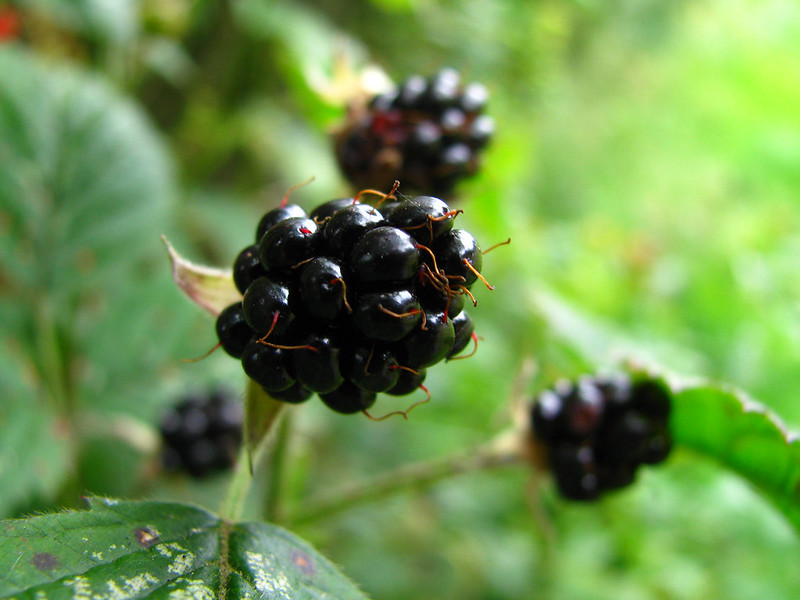
Trailing Wild Blackberry
Although much of the farm was overgrown by tangled canes of Himalaya Blackberry when we moved in, these native trailing blackberries had spread out over fences and grown in lush, trip-inducing carpets over large parts of the pasture. Though we claimed the pasture for horses, vines continue to grow just beyond the reach of equine nibbling. These wild berries ripen in early July, almost a month before their invasive counterparts. As for the flavor? Heavenly. The berries may be dainty, but their flavor is well-balanced with sweet and tartness and lingers on while you pick the next handful.

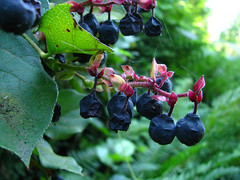
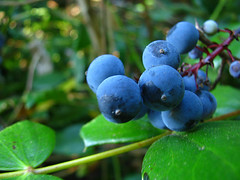
Blackberries, Salal and Oregon-Grape
In the past I've referred to Himalaya blackberries as my nemesis. In late summer, our relationship mellows and I find myself stickily enjoying their profuse, juicy, and shockingly sweet berries. They help define summer in the northwest: bees in the blossoms, unconscionably delectable cobblers, and fresh berries with ice cream. I'm appreciating it while it lasts. Soon autumn will come and I'll return to drawing new borders in my ongoing territory dispute with the blackberry hegemony.
Salal is a native plant that doesn't receive the same culinary attention as its edible peers. It has bell-shaped flowers that become sweet berries with an aftertaste that reminds me of English breakfast tea. The texture is somewhat undesirable — sticky on the outside, with thick skin and a seed-filled interior. I've heard about salal being used in jams and pies, but have only ever tried it myself as a fresh snack.
Oregon-Grape has the distinction of being my least-favorite of the native berries. Though the lightly-dusted blue berries look quite similar to grapes, they're scarcely palatable. The fruit are sharply tart and have large seeds. The leaves do not resemble grapes at all — in fact, they have a prickly quality very reminiscent of holly. These berries might be enjoyed when mixed with other, sweeter fruit, but on their own I do not savor them at all.
‘12
It reminds me that we came
To mend the damaged land
To tend its neglected corners
To coax its beauty into bloom
‘12
Granny and the Garter Snake
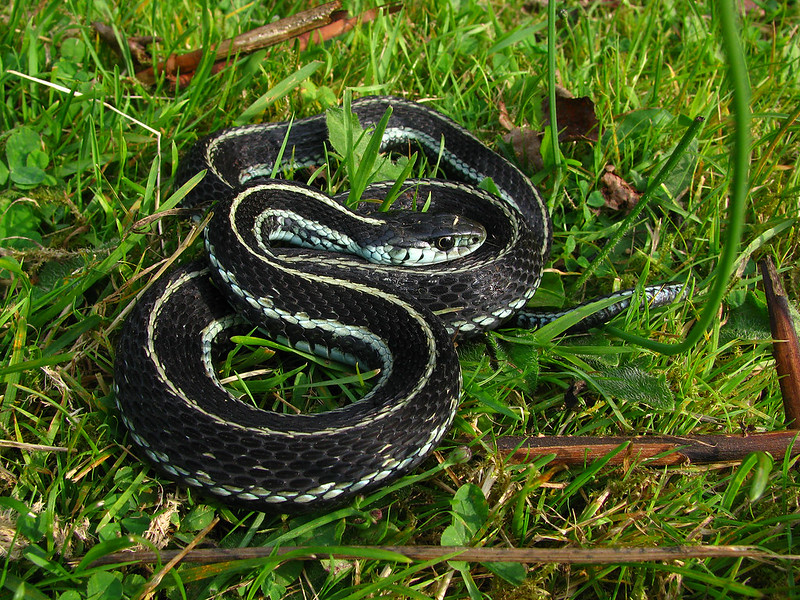
Puget Sound Garter Snake
Yesterday we returned home to see a snake sneaking across our kitchen, away from a cat who was watching it intently — almost certainly the same cat who had proudly carried it as a trophy into the house. Remembering that our only local snakes are garter snakes, we hastened to rescue the troubled reptile. The snake cooperated with us by hiding in a grocery bag that we then used to carry it outside.
After noting its beautiful blue underbelly and identifying it as Thamnophis sirtalis pickeringii (Puget Sound Garter Snake), we deposited the slightly-wounded garter snake in our strawberry bed, hoping it would help control our slug problem. So far, so good: today's strawberries were free of slug bites, though there was no sign of the snake.
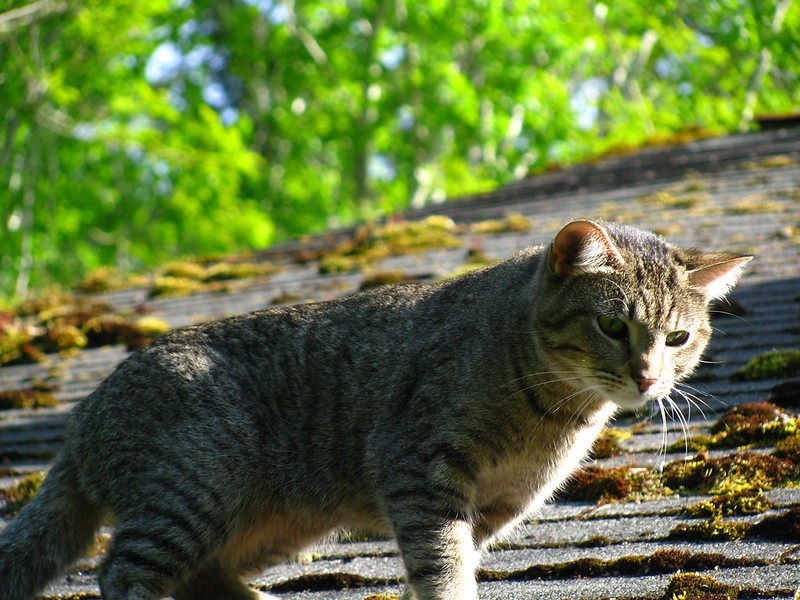
"Granny" (Granite) patrolling the rooftop.
Perhaps the most surprising part of the snake in the house was its captor. Granite is the youngest of our cats, and hasn't earned a reputation as a hunter. She repudiates catching mice and had thus far best distinguished herself by catching mosquitos in the bedroom.
She seems to have found a category of prey that suits her, though. She followed yesterday's catch with another this afternoon. She and her brother were scrabbling at the skirt of the refrigerator, indicating they'd lost something of interest. When we moved the fridge, it turned out to be an alligator lizard without half its tail. We disappointed the cats by returning the lizard to the wild, but noted Granite's growing skill and avidity.

